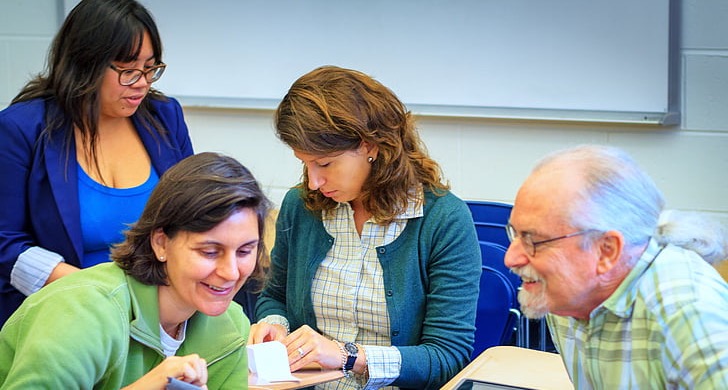
Andragogy & Neuroplasticity
Andragogy is an adult learning theory. Adults learn differently than children do. Adult learners include higher education students as well as their instructors who might be seeking additional training or professional development. Adult learners might choose subjects and courses based on personal background and experience, but also may be required to take courses based on degree program or professional requirements such as gaining or improving job skills. Younger learners are motivated by grades and praise, but adult learners are more motivated based on internal reflection and personal interests. In K-12 learning is subject-centered, tending to address more introductory levels of Bloom’s Taxonomy, but higher education needs to be problem-centered to better address the higher-level thinking skills of Bloom.
Neuroplasticity affects how adults learn. At younger ages, neurons are still forming in a growing brain, which is why certain memories and skills seem stronger when experienced at younger ages compared to when learned as an adult. Adult learners, whose brains have stopped growing at around age 16, need to experience their learning, because “if you don’t use it, you lose it”. More experiences are required for adult learners for learning to “stick”, but at the same time adult learners can be expected to be more self-directed and can also bring their own previous experiences to build upon.
Andragogy Definition and Principles:
https://learning-theories.com/andragogy-adult-learning-theory-knowles.htmlBloom’s Taxonomy:
https://www.bloomstaxonomy.net/Neuroplasticity Definition:
https://www.psychologytoday.com/us/basics/neuroplasticityNeuroplasticity and Learning:
https://elearning.adobe.com/2019/05/neuroplasticity-role-learning-memory/
Generational learning differences refer to the ways in which different groups of students, based on their age and birth year, may have different learning preferences or process information differently.
These differences can be attributed to a variety of factors, such as changes in technology, social norms, and cultural influences. Some examples of generational learning differences include the way that younger generations are more accustomed to digital and visual forms of learning, while older generations may prefer more traditional, lecture-based methods. Additionally, younger generations may have different learning styles and preferences than older generations, due to differences in their experiences and exposure to different forms of education.
- Baby Boomers (born 1946-1964) tend to prefer a traditional classroom setting, with a clear hierarchy and a focus on lectures and textbooks. They are often self-directed learners and value face-to-face interactions with their instructors.
- Generation X (born 1965-1980) students tend to be more independent and self-reliant. They value a mix of traditional and non-traditional teaching methods, and may prefer a more flexible classroom environment. They also value technology and its use in education.
- Millennials (born 1981-1996) often referred to as "digital natives" are comfortable with technology and expect it to be integrated into their learning experience. They value collaboration, hands-on learning, and immediate feedback. They also tend to have a global perspective and be more diverse.
- Generation Z (born 1997-2012) also known as "digital natives" have grown up in an even more technology-saturated environment than millennials and as such are very comfortable with technology, they value personalization and flexibility in their learning, and they appreciate a mix of online and in-person instruction.
To account for generational learning differences in classroom instruction, instructors can use a variety of strategies that address the diverse learning preferences and styles of their students.
Some possible strategies include:
- Differentiated instruction: This approach involves tailoring instruction to meet the individual needs of different students, including those from different generations. It can involve using a variety of teaching methods, such as lectures, discussions, hands-on activities, and online resources, to accommodate different learning styles.
- Incorporating technology: Using technology in the classroom can help engage students from all generations, but particularly those from the millennial and Gen Z groups, who are comfortable with technology and expect it to be integrated into their learning experience.
- Encouraging collaboration and teamwork: Creating opportunities for students to work together in small groups or teams can help to foster a sense of community and engagement among all students, particularly those from the millennial and Gen Z groups, who value collaboration and hands-on learning.
- Using formative assessment: Giving students frequent opportunities to self-assess and receive feedback on their progress can help to ensure that all students are on track and understanding the material.
- Providing flexibility: Offering flexible options for when, where and how students complete assignments and assessments, such as online assignments, can accommodate different student preferences, such as those of Gen Z who appreciate personalization and flexibility in their learning.
- Encourage a global perspective: Encourage students to think beyond the classroom and their immediate environment, and to consider the perspectives of people from different cultures, backgrounds, and generations.
- Be open to student feedback: Encourage students to provide feedback on the instruction, this can be done through surveys, focus groups or one-on-one meetings, this can help instructors to understand the student's perspective and adapt instruction accordingly.
- Supporting 4 Generations of Learners Using Panopto: https://www.panopto.com/blog/are-you-ready-to-support-4-generations-of-learners/
- Preferred Learning Methods of Gen Z: https://digitalcommons.salve.edu/cgi/viewcontent.cgi?article=1075&context=fac_staff_pub
- Mobile Technology and Generation Z in the English Language Classroom: https://www.mdpi.com/2227-7102/9/3/203